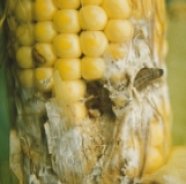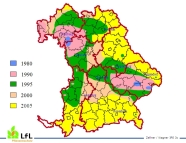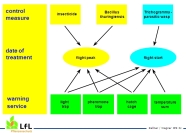
Control of the European corn borer - What possibilities are there and what is to be paid attention to?

Larva of the European corn borer
Development of the European corn borer infestation in Bavaria
 Zoombild vorhanden
Zoombild vorhanden
Figure 1:Development of the European corn borer infestation in Bavaria
The occurrence of the European corn borer (Ostrinia nubilalis) was initially limited to warmer regions (Mediterranean countries, Rhine rift). In the last decades, the insect has spread out more and more to regions with less favourable climatic conditions. By the end of the seventies the European corn borer occurred in Bavaria for the first time. Since then it has widely spread and since 2005 it can be found in almost every maize plot in Bavaria (Figure 1). According to estimations of the World Food Organization (FAO), four percent of the maize harvest are destroyed worldwide by the borer's caterpillars annually. This corresponds to the food requirements of 60 million people.
Multiple damage
Maize tassels folded over or broken off are distinct signs for the larvae's feeding activity. On closer examination, cavities show at the breaking points, with material produced by boring into the stem and excrements. Both are found in the leaf axils situated beneath. The bored tunnels inside the stem may reach from the tassel inside the top of the stalk to the stem base. Often bore holes and feeding tunnels can also be found in the ear. Bored tunnels and holes along the stem being produced by the repeated boring in and out impair the mechanical stability of the maize plant. As long as only the upper parts of the stem bend, the damage can be neglected. But especially in years with frequent thunderstorms plants break off in the lower section. Under such conditions, a great part of the ears can not be seized, not even with row-independent harvesting methods. Besides, the larvae's maturation feeding hinders water and nutrients supply as well as transport of assimilates. With two to three caterpillars per plant yield reduction of 10 to 30 percent can be expected in the long-term average. In addition, the larvae promote fungal infections by their boring activity. Primarily important in this context are Fusarium spp. They cause stalk and ear rot, and under certain conditions they produce mycotoxins such as deoxynivalenol or nivalenol, which reduce forage quality considerably.
Development of the corn borer
From June on, fist moths fly from last-year’s maize fields into the new crops. In most cases, migration reaches its peak in July, but continues well into August. Female moths fly in the evening and night hours and deposit their whitish eggs in clusters on the underside of maize leaves. Larger leaves in the middle of the plant are preferred for egg deposition. The average clutch size is about 10 to 20 eggs. One to two weeks later, yellowish-coloured little caterpillars eclose. Eggs as well as young larvae are very sensitive to humid and cool weather. Then the borer larvae spread to neighbouring plants and bore into the upper part of the maize plant. In the course of the growing season, they feed downwards inside the stalk, partially interrupted by boring in and out anew. The older the larvae are, the further they advance downwards and the greater is the damage caused. That is why control measures must be set in a way that the first batches of eggs or larvae - depending on the control method - are seized definitely. Hibernation takes place in maize stubbles. The pest pupates the following May.
Best control measure: deep ploughing under of maize stubbles
In silage maize production chopping off maize plants very low can reduce a population of corn borer for the following year. Crushing of stubbles and straw by rotary tiller or disc harrow is also suitable for killing caterpillars. But experience has shown, that these measures on their own are not sufficient to keep the European corn borer population below the damage threshold. Only a deep (25 cm), clean ploughing-under of maize stubbles and straw is a control method promising success in the long run. Thus, hatching moths are hindered in leaving the soil. An additional attachment for the plough, to put the straw well into the furrow, is necessary. If the deep turning soil cultivation is practised in the entire infestation area, the European corn borer has hardly any possibilities for further development. In most cases further controlling measures are not necessary. The ploughing-under of maize residues reduces the Fusarium toxin risk for the following crop wheat at the same time.
Chemical and biological control methods and genetic engineering
 Zoombild vorhanden
Zoombild vorhanden
Figure 2: Control measures and warning service
Considering economic or plant production aspects it can make sense to work without a plough. In some cases ploughing is not possible for reasons of erosion protection. Very clayey or shallow soils exclude a deep turning tillage from the beginning. Under these conditions, the following possibilities to reduce damage are available (compare Figure 2).
Use of insecticides
Here synthetic pyrethroids as Baythroid 50 (750 ml/ha) have to be mentioned. These products only affect the corn borer caterpillars. For this reason, the spraying should be done when first caterpillars start to bore into maize stems. According to experience, this is the case at the flight-peak. Since at this time the maize has reached a height of around 1.5 m, the use of a high-clearance tractor is necessary to avoid losses due to driving. Too early sprayings give away part of the effective period, the success of control decreases correspondingly. Our trails have shown that with ideal timing efficiencies of 75 percent, in the average of several years, can be obtained (Figure 3). However, it is to be taken into account, that spraying of insecticides equally seizes beneficial organisms. In some years the elimination of ladybirds and larvae of green lacewings is followed by a massive aphid infestation in the treated maize plots.
| Method Year of experimentation | Insecticide (1X) 1992 to 99 | Trichogramma (2x) 1992 to 99 | Bt-Maize 1997 to 99 |
|---|---|---|---|
| % efficiency* (n=11) | % efficiency* (n=11) | % efficiency** (n=6) | |
| Average (from ... to) | 75 (33 - 93) | 55 (35 - 81) | 95 (88 - 100) |
* efficiency compared to non-treated variant; ** efficiency compared to isogenic cultivar without Bt-construct; source: data form AELF Ansbach modified
Biological control
Trichogramma - parasitic wasps lay their eggs into the egg batches of the European corn borer. After some days a new generation of parasitic wasps, instead of the European corn borer caterpillars, eclose which immediately seek for appropriate batches of the corn borer's eggs again, for their next generation. The beneficial organisms can be put into endangered maize plots in little cardboard frames or capsules (trade name "Trichocap") and small plates ("Trichosafe") respectively. The advantage of this method is that other beneficial organisms like ladybirds are not damaged and no facilities are required for application. A good effect is achieved if beneficial organisms are released at the beginning of the corn borer's flight period and once more eight to ten days later. Under these conditions in our trials, the number of caterpillars could be reduced, in the average of several years, by 55 percent. In case of a medium infestation pressure, this effectiveness normally is sufficient to avoid yield losses. In case of strong rainfall (thunderstorms) immediately after the release, the parasitic wasps are impaired to a high degree; then the success of this control method is considerably lower.
A further possibility is the application of Bacillus thuringiensis preparations. This biological insecticide with the trade name "Dipel" is only effective against European corn borer's caterpillars. For this reason, the same operational conditions apply as to synthetic pyrethroids. No harm is done to beneficial organisms according to previous experiences. However, the preparation had a minor effect in our trials. The success of control was less than 30 percent. With strong sun radiation the product’s effect only lasts a few days.
Bt maize protects itself
With Bt maize, maize cultivars are available which protect themselves against the European corn borer's caterpillar. A gene of the soil bacterium Bacillus thuringiensis (therefore Bt maize) was transferred into the genetic information of this maize grown in Northern America since 1996. In contrast to traditional maize varieties, Bt maize produces a substance toxic to the larva of the pest, the so-called Bt protein - comparable to the biological insecticide "Dipel". As soon as the caterpillars bore into the maize plant, they ingest the Bt protein and die. An effect on non-target organisms within the maize crop (including the microbial soil life) has not been observed in our experiments.
The Bayerische Landesanstalt für Landwirtschaft (Bavarian State Research Centre of Agriculture) carries out field experiments with maize resistant to the European corn borer since 1997. In Bt maize varieties the number of larvae could be reduced by 95 percent compared to not transformed varieties (Figure 3). Besides that, in plants equipped with the Bt gene, no stem breaking occurred, while the respective non-transgenic variant showed bent stems up to 25 percent. From a specialist view, transgenic maize varieties currently are the best possibility for the control of the European corn borer. Though in connection with Bt maize one must keep an eye on the question of breaking the resistance. - A summarizing evaluation of the different control methods is shown in Figure 4.
| Control method | man-hour/ha | Management needs | Impairment of beneficial organisms | Succes of control | Costs €/ha* |
|---|---|---|---|---|---|
| Trichogramma | 1 | high | low | satisfactory | 75 |
| Insecticide | 0.5 | medium | high | good | 40** |
| Bt Preparation (Dipel) | 0.5 | high | low | small | 95** |
| Bt Maize | low | low | very good | 45 |
* including value-added tax; ** using corporate mechanization; without costs caused by driving damage


